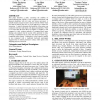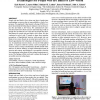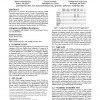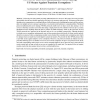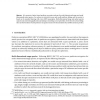ASSETS
2015
ACM
8 years 9 months ago
2015
ACM
Poor spelling is a challenge faced by people with dyslexia throughout their lives. Spellcheckers are therefore a cru cial tool for people with dyslexia, but current spellchecker...
ASSETS
2015
ACM
8 years 9 months ago
2015
ACM
Detecting dyslexia is crucial so that people who have dyslexia can receive training to avoid associated high rates of aca demic failure. In this paper we present Dytective, a ga...
ASSETS
2015
ACM
8 years 9 months ago
2015
ACM
This paper describes a study examining the usability of OnScreenDualScribe (OSDS), a tool to support individuals with physical disabilities with text entry and cursor movement. A ...
ASSETS
2015
ACM
8 years 9 months ago
2015
ACM
Technology workers are often stereotyped as being socially awkward or having difficulty communicating, often with humorous intent; however, for many technology workers with atypic...
ASSETS
2015
ACM
8 years 9 months ago
2015
ACM
People who are blind or low-vision may have a harder time participating in exercise due to inaccessibility or lack of experience. We employed Value Sensitive Design (VSD) to explo...
ASSETS
2015
ACM
8 years 9 months ago
2015
ACM
In this paper, we introduce the American Sign Language STEM Concept Learning Resource (ASL CLeaR), an educational application demo. The ASL CLeaR addresses a need for quality ASL ...
ASSETS
2015
ACM
8 years 9 months ago
2015
ACM
The advent of system-wide accessibility services on mainstream touch-based smartphones has been a major point of inclusion for blind and visually impaired people. Ever since, rese...
ASSETS
2015
ACM
8 years 9 months ago
2015
ACM
Blind children engage with their immediate environment much less than sighted children, particularly through self-initiated movement or exploration. Research has suggested that pr...
PKC
2015
Springer
8 years 9 months ago
2015
Springer
Protecting user data entails providing authenticated users access to their data. The most prevalent and probably also the most feasible approach to the latter is by username and pa...
PKC
2015
Springer
8 years 9 months ago
2015
Springer
Abstract. We construct a lattice-based predicate encryption scheme for multi-dimensional range and multidimensional subset queries. Our scheme is selectively secure and weakly attr...

